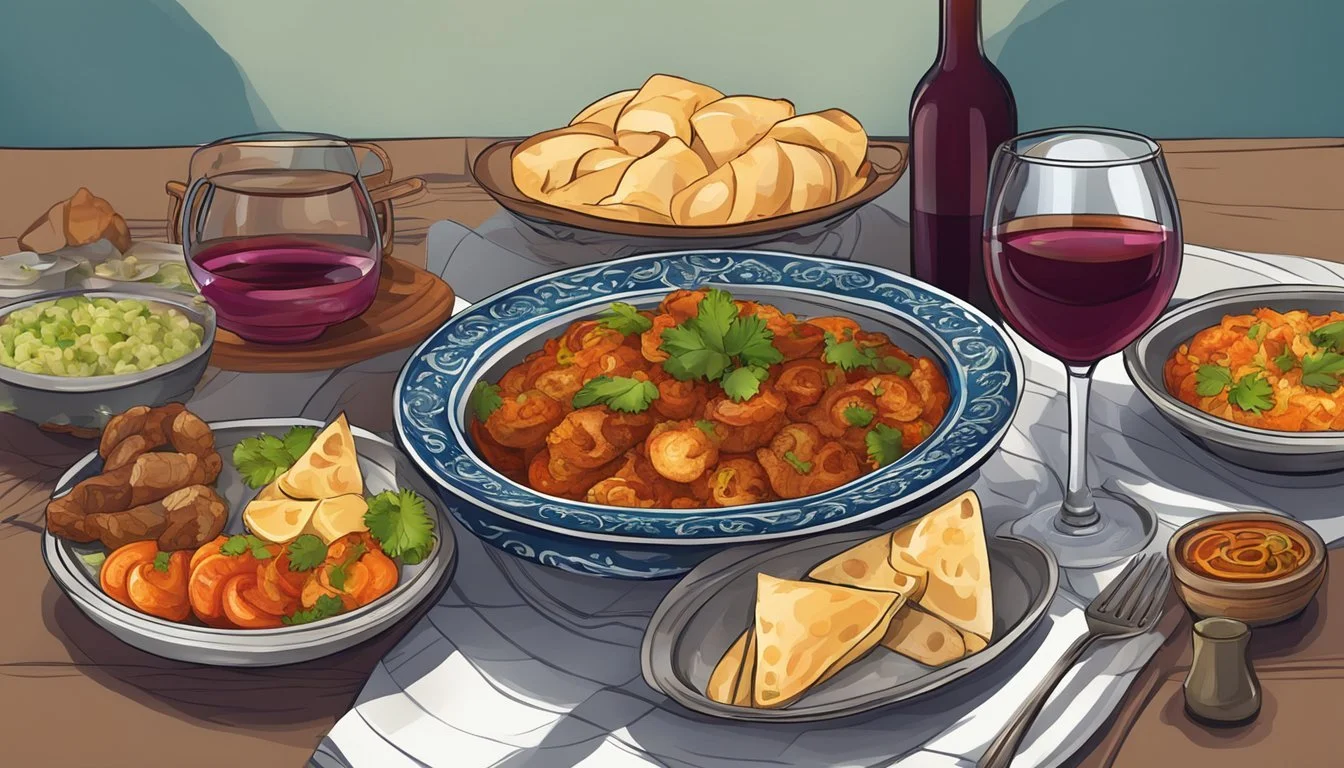What Wine Goes Well with Azerbaijani Food
Expert Pairing Tips
Azerbaijani cuisine offers a rich tapestry of flavors and textures that present a delightful opportunity for wine pairing. Rooted in regional ingredients and traditional recipes, Azerbaijan's dishes range from succulent meats to fresh vegetables, each requiring thoughtful selection of wine to complement their distinct tastes. When considering wines to pair with Azerbaijani food (What wine goes well with Azerbaijani food?), one must take into account the balance of spices, the method of cooking, and the prominence of ingredients like lamb and fresh herbs that characterize this culinary tradition.
Understanding the flavor profiles of Azerbaijani dishes is crucial in selecting the perfect wine. For example, the traditional dish Buglama, a lamb stew steamed with onions, tomatoes, and aromatic spices, pairs well with wines that can stand up to its hearty richness without overwhelming it. Here, a wine that offers both body and subtlety would enhance the dining experience. On the other hand, lighter Azerbaijani fare, such as grilled vegetables or salads dressed with pomegranate, finds its match in wines that mirror their freshness and acidity.
The practice of pairing wine with Azerbaijani food is not merely about finding a complementing beverage; it is an exploration of culture and taste. Wine enthusiasts and food connoisseurs alike are encouraged to consider how the terroir of the wine can reflect or contrast the flavors found in Azerbaijani dishes. Whether dining on robust kebabs or delicate pastries filled with nuts and honey, the right wine selection elevates the meal, creating a harmonious culinary union.
Azerbaijani Cuisine Overview
Azerbaijani cuisine reflects the country's unique position at the crossroads of Europe and Asia, where Middle Eastern flavors meet Mediterranean influences. Utilizing a diverse palette of ingredients found across Azerbaijan's regions—Baku, Ganja, Nakhchivan—and the surrounding lush Caspian Sea area, the culinary traditions are deeply intertwined with the nation's culture and history.
Key Ingredients in Azerbaijani Cooking
Azerbaijani dishes are replete with fresh herbs, spices, and locally sourced produce. Staple ingredients often include lamb, rice, and a variety of vegetables like tomatoes, onions, garlic, and chickpeas. Yogurt is used extensively as a condiment or base for sauces and soups.
Lamb: A primary meat in many dishes due to the pastoral traditions.
Rice: Essential for Plov (rice pilaf), a hallmark of Azerbaijani cuisine.
Herbs and Spices: Fresh and dried herbs add complex flavors; spices range from mild to vibrant.
Vegetables: Commonly found in stews (What wine goes well with stews?) and stuffed dishes.
Yogurt: Adds creaminess and tang to savory dishes.
Azerbaijan's Traditional Dishes
Many traditional recipes such as Plov, Kebabs, Dushbara, and Lavangi grace the Azerbaijani table. Shah Plov stands out with its crown of dried fruits (What wine goes well with dried fruits?) and nuts, while Buglama offers a hearty stew-like experience. Desserts such as Baklava reveal a sweet dimension to the cuisine.
Plov: A cherished rice dish featuring different combinations of meats, dried fruits, eggs, and spices.
Kebabs: Grilled meats, (What wine goes well with grilled meats?) often lamb, served with vegetables.
Lavangi: Stuffed meat (chicken, fish, or duck) with nuts, seasonings, and sometimes tart fruit flavors.
Cooking Techniques and Styles
Azerbaijani cooking is characterized by methods such as grilling, stewing, and baking. The outcome is a variety of textures and nuanced flavors—an interplay of tender meats, fluffy grains, and vibrant herbs.
Grilling: Achieves a flavorful, smoky sear on meats and vegetables.
Stewing: Slowly cooks ingredients to create depth of flavor and tenderness.
Baking: Used for bread, pastries, and complex dishes like Lavangi, encasing flavors to perfection.
Wine Pairing Essentials
The essence of wine pairing with Azerbaijani cuisine lies in understanding flavor synergies and how the characteristics of wine influence the dining experience.
Understanding Wine and Food Pairings
The intricate dance of wine and food pairings revolves around the balance of flavors and textures. Azerbaijani food, known for its savory spices and hearty dishes, can be complemented by wines that match the intensity of these flavors. Pairing wine with Azerbaijani food should consider the following aspects:
Flavor harmony: For example, savory dishes like plov, a spiced rice dish, can resonate well with a full-bodied white wine that has a slight oak influence, enhancing the rich flavors without overshadowing them.
Texture compatibility: Hearty stews with robust textures can benefit from the structure of a red wine with firm tannins, providing a counterbalance to the dish's density.
Impact of Wine Characteristics
Wine characteristics play a vital role in pairing. With Azerbaijani cuisine ranging from spicy kebabs to sweet baklavas, selecting the right wine is crucial:
Body: The body of the wine should match the richness of the dish. A full-bodied red wine can stand up to the bold flavors of lamb-based dishes, while a lighter white wine might be better suited for delicate flavors like those found in dolma (stuffed grape leaves).
Dish Wine Body Lamb Kebab Full-bodied red Dolma Light-bodied white
Acidity: High-acid wines can cut through the fattiness of dishes, refreshing the palate. A white wine with crisp acidity could complement the fat in a dish like qutab, which is a stuffed flatbread.
Azerbaijani Dish Wine Acidity Qutab High-acid white
Sweetness and Spice: Spicy dishes (What wine goes well with spicy dishes?) might benefit from a wine with a touch of sweetness to soothe the heat, while the sweetness in desserts, such as baklava, calls for a wine that is at least as sweet to avoid being overpowered by the confection's sugar content.
Dish Wine Sweetness Kebabs Off-dry rosé Baklava Sweet white
Understanding the foundational elements of pairing Azerbaijani food with the right wine relies on these principles, which aim to create a harmonious and memorable dining experience.
Azerbaijani Wine Heritage
Azerbaijan's wine heritage is deeply rooted in its history and geography, featuring a unique blend of traditional practices and indigenous grape varieties that contribute to its distinctive winemaking culture.
Historical Development of Winemaking
The practice of winemaking in Azerbaijan dates back to ancient times, deeply intertwined with the nation's history. As a crossroad along the Silk Road, Azerbaijan benefited from the exchange of goods, ideas, as well as viticultural techniques with neighboring regions, such as Georgia, Armenia, and beyond. The Caucasus Mountains have provided a favorable terroir for vine cultivation, fostering a winemaking tradition that has survived through various historical epochs, including the ancient Shirvan principality and periods of both Persian and Russian influence. Despite changes in political landscapes, Azerbaijani winemaking has persisted and is now experiencing a revival.
Wine Regions of Azerbaijan
Azerbaijan boasts several wine regions, each with its own unique terroir and climatic conditions favorable to viticulture:
Shirvan: Known for its mild climate and fertile soil, suitable for a range of grape varieties.
Ismayilli and Gabala: Regions characterized by their temperate climates and high altitudes, which contribute to the subtle complexities of the wines produced here.
Meysari: A newer viticultural area that utilizes modern winemaking techniques while maintaining the distinct Azerbaijani character.
Indigenous Grape Varieties
Azerbaijani wine is made from a mix of international and indigenous grape varieties. Among the local grapes, some stand out for their contribution to the country's viticultural identity:
Rkatsiteli: A pale-skinned grape variety known for its ability to produce aromatic white wines.
Saperavi: Often associated with neighboring Georgia, this variety also thrives in Azerbaijan, yielding deeply colored and richly flavored red wines.
Madrasa: A local specialty that is often used to make semi-sweet to sweet dessert wines, exhibiting the diverse potential of Azerbaijan's vineyards.
Azerbaijan's indigenous grapes reflect the country's winemaking heritage and are key to the unique profile of the local wines, positioning them to pair well with the rich and varied flavors of Azerbaijani cuisine.
Recommended Wine Varietals for Azerbaijani Dishes
In Azerbaijani cuisine, the rich tapestry of flavors from savory meats, aromatic spices, and fresh herbs demands wines that complement and enhance these tastes. Pairing the right wine with Azerbaijani food can turn a meal into an exquisite gastronomic experience.
Red Wines for Hearty Azerbaijani Meat Dishes
Azerbaijani meat dishes, such as kebabs and lamb stews, are often seasoned with robust spices and can be quite hearty. To match the richness of these meats, certain red wines excel:
Shiraz/Syrah: Bold and spicy with dark fruit flavors, it stands up well against the savory and spicy notes of meat dishes.
Cabernet Sauvignon: With its full body and tannic structure, this wine is an excellent partner for rich Azerbaijani lamb preparations.
White Wines for Lighter Azerbaijani Fare
For lighter dishes, particularly those that incorporate yogurt or less intense spices, a more delicate wine can provide balance without overpowering the flavors:
Chardonnay: A versatile choice, especially when unoaked, it complements dishes like Azerbaijani plov (rice pilaf) that may have subtle flavors of herbs and spices.
Viognier: Floral and aromatic, Viognier works well with dishes that have a slight sweetness or are seasoned with fragrant spices.
Riesling: Its range from dry to sweet and its vibrant acidity make Riesling a refreshing counterpart to lightly spiced fare.
Rosé and Regional Wines
Azerbaijani wine, known locally as şərab, taps into both local and international grape varieties and can offer fascinating pairings with the country's diverse cuisine:
Rosé: A crisp rosé can contrast the richness of spiced meats while complementing the freshness of herbs.
Azerbaijani Wine Varietals: Local wines made from indigenous grapes such as Derbendi and Marandi may provide an authentic and harmonious match with both bold and subtle dishes, celebrating the true essence of the region's flavors.
Wine Serving and Storage Tips
When selecting wine to complement Azerbaijani dishes, proper serving and storage are crucial to ensure the best tasting experience. The ideal temperature for serving wine varies: red wines typically between 60°-68°F, and white or sparkling wines at a cooler 45°-50°F. Azerbaijani cuisine, rich in spices and flavors, pairs splendidly with well-chilled, aromatic white wines that can accentuate the complex culinary profiles.
For storage, wines should be kept in a controlled environment. Here's a simple guideline:
Wine Type Storage Temperature Red Wine 55°-65°F White & Rosé Wine 45°-55°F Sparkling Wine 40°-50°F
Glassware also plays a vital role. A wide-bowled glass is best for reds, allowing their aromas to unfold, while whites and rosés are served in narrower glasses to concentrate their more delicate scents.
When it comes to presentation, wine should be poured with grace, filling the glass to just about one-third to allow the wine to breathe and for the aromas to be appreciated. Moreover, the bottle should be presented to showcase its label before serving.
In summary, attentiveness to wine selection, temperature, glassware, and presentation elevates the Azerbaijani culinary experience. Wine enthusiasts will find these tips valuable in enhancing the enjoyment of the region’s rich, flavorful cuisine.
Culinary Journeys in Azerbaijan
When traversing Azerbaijan, a country poised on the cusp of the Caspian Sea, one is enveloped by a rich tapestry of food and wine, deeply intertwined with the nation's cultural ethos and traditions.
Wine Tourism and Gastronomy in Azerbaijan
The rise of wine tourism in Azerbaijan complements its culinary landscape, offering an immersive experience for enthusiasts eager to explore native grape varieties and the local gastronomy. Nestled between the Caucasus Mountains and the Caspian Sea, the region's climate and topography are propitious for viticulture. Visitors to Baku, Ganja, and the Shirvan region can embark on wine tours, pairing local vintages such as Matrasa or Bayanshira with regional specialties. Azerbaijani cuisine, often a fusion of Middle Eastern and Mediterranean flavors, is typified by dishes such as lavangi, a walnut and pomegranate stuffed chicken or fish, enhancing the tasting experience.
Cultural Significance of Food and Wine
Azerbaijani culture venerates the ritual of shared meals, regarding food and wine as conduits of hospitality and friendship. The culinary heritage, steeped in history, mirrors Azerbaijan's position along ancient trade routes, amalgamating diverse culinary methods and ingredients. In Azerbaijan, every meal, especially when paired with regional wines, is a celebration of its rich, storied past—an extension of their renowned hospitality.
Dining Etiquette and Traditions
The customs surrounding food and wine in Azerbaijan are both a testament to the nation's hospitality and a reflection of its historical traditions. A traditional table is not complete without a variety of breads like lavash, illustrating the nation's agrarian roots. Dinners commence with a series of appetizers or mezze, followed by main courses dominated by grilled meats and stews, best enjoyed with a glass of local wine. In Azerbaijani tradition, ending a meal with a sweet tea signifies respect and contentment, rounding off a culinary journey that captivates the palate and the heart.
Conclusion: Embracing Azerbaijani Flavors
Pairing wine with Azerbaijan’s rich culinary landscape can enhance a dining experience, offering a foray into a world where tradition and modernity converge. Azerbaijan’s gastronomy is characterized by a variety of vibrant flavors that are best complemented by wines that respect and highlight these tastes.
Local Pairings:
Azerbaijani wines, such as those made from indigenous grape varieties like Zeynabi and Marandi, are optimally suited for local dishes. White wines like Rkatsiteli or a light Pinot Blanc can be paired with dishes such as Buglama, balancing the hearty lamb with their crisp acidity.
For Stews: Robust reds such as Saperavi or Cabernet Sauvignon will match the intensity of lamb stews.
For Grilled Meats: Lighter reds or rosés can complement grilled kebabs without overwhelming the palate.
Hospitality Tradition: The hospitality inherent to Azerbaijani culture is mirrored in the careful selection of wines to accompany meals. Wine is not merely a beverage but a part of the culinary journey, enhancing the communal experience at the table.
Embracing Local Wines: Guests are encouraged to indulge in Azerbaijani wine offerings, which reflect the terroir and viticultural history. By choosing local wines, one not only embarks on a journey through Azerbaijan's culinary repertoire but also supports the burgeoning wine industry. These pairings pay homage to the country's deep-rooted winemaking heritage.
One navigates through Azerbaijan's culinary landscape confidently with these pairings, ensuring a rich and harmonious dining experience. It's a testament to the vibrant identity of the country's food and wine culture, inviting everyone to an inclusive celebration of flavors.









